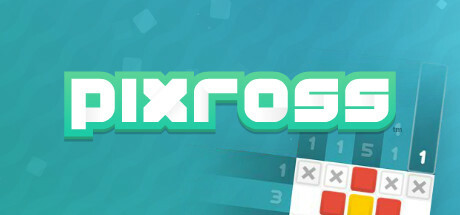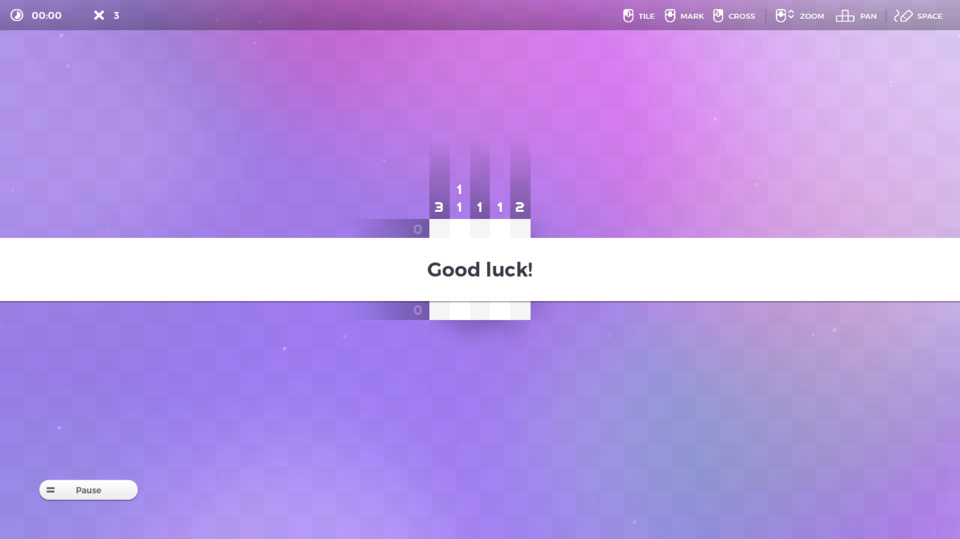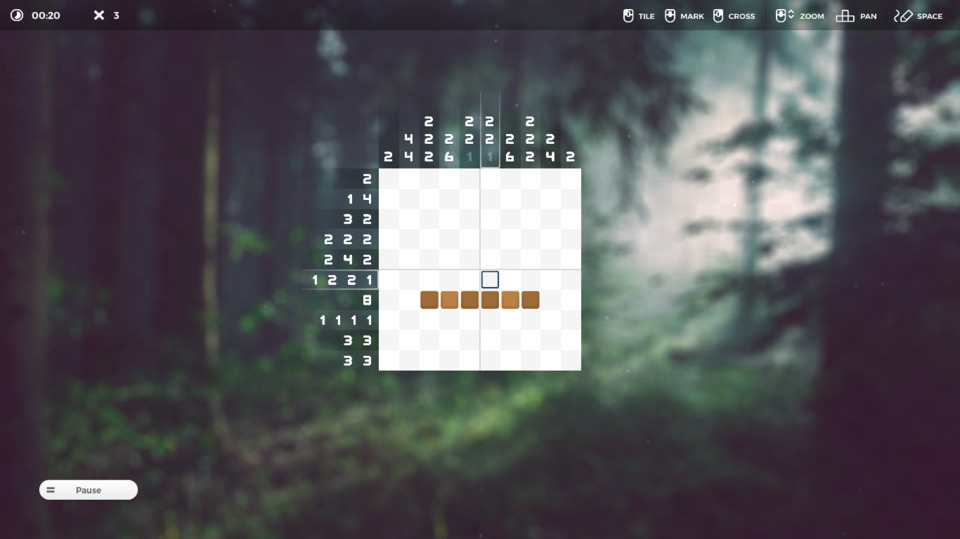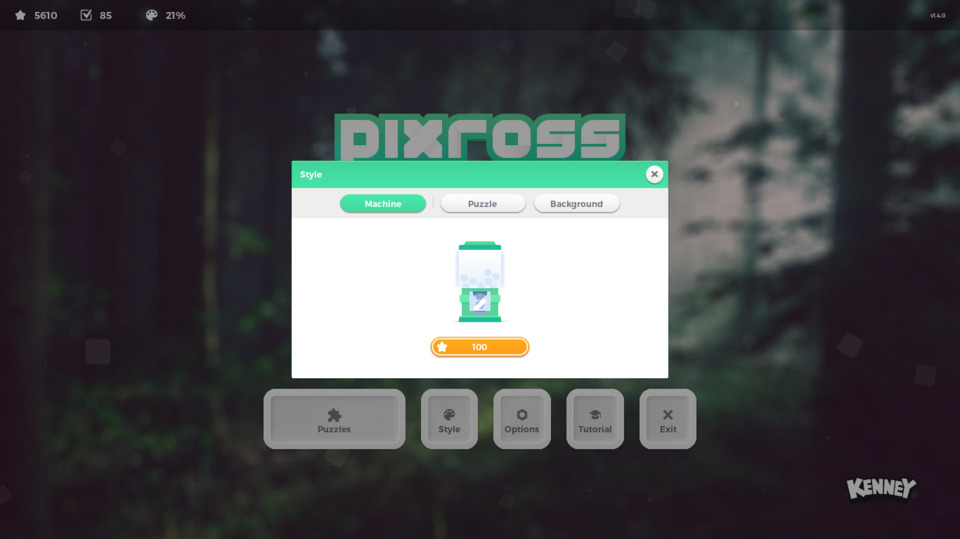
After a few unsuccessful attempts to get a few other Indies running on this potato - I really need to upgrade soon; it's a thing when I can't even get pixel platformers to run at an acceptable framerate - I fall back to my usual lo-fi option: a picross game. Kinda hard to make a picross game that doesn't run on everything, unless it's 3D or something. Pixross was released in 2020 by Kenney, a Dutch studio best known for producing free-to-use art assets for developers, and is at first blush a slick but otherwise no-frills picross game with a modest 180 puzzles (I believe 20 of those may have been added after the fact in some free updates) and a few cosmetic extras. However, Pixross has some notable differences to picross games I've played in the past, and I can't be sure whether the developer aimed for a different approach out of an honest desire to set itself apart or if they decided to try their hand at a picross game without picking up on all the mostly unwritten rules of how the format operates. I'll have to do some explicating a little further in to explain what I mean, but I'm a little grateful the developer gave me something distinct to review. Not easy to fill a thousand-word review on a picross game, given how standardized the genre is.
Pixross has the cadence of a mobile game but I don't believe it was ever released on those platforms: I have the Itch.io version, since it was part of this summer's enormous Palestinian Aid bundle, though it's also available on Steam. When I say a mobile game's cadence, I mean that the UI, aesthetic, and the general serene ambience is very much of that colorful, round-edged softness beloved of mobile gaming - that eagerness to put the player at ease and provide a respite from whatever commute or post-work stress they might be feeling. That's often a component of puzzle games too, especially non-demanding ones like picross or sudoku, but either way the game leans into that relaxed attitude and might go a ways into explaining the game's divergent mechanics, many of which make the game even easier.

So enough beating around the bush: the game makes some strange mechanical choices that I don't think I've seen in any picross game. The first is how the player can either fill or flag a tile: the former is confirming that the chosen square is part of the image, and the choice to fill that tile is usually a permanent one in most picross games. If it's not actually part of the puzzle, the player is often then penalized. However, Pixross also has the same rule for flags: if you put a flag (usually a cross) in a space that you know to be empty, it's often treated as a temporary measure that the player is free to reverse at any time if they change their mind, in contrast to the fills. However, Pixross treats them the same way: if you indicate that a tile is not part of the image, that decision is permanent and you'll be penalized if it was an error. I often play around with the flags as a means to understand where a line might overlap - say, if there's a 7 and a 4 as the hints and the image is 15x15, I'll start the 7 and 4 from one side and then from the other to see where they overlap and then fill those overlapping spaces - but that's obviously not an option in this game. I had to train myself not to be quite as reliant on those flags unless I was sure there was nothing there.
The second, even wilder change relates to how the hints work. In a regular picross game the hints across the top and left side of the puzzle indicate how many tiles need to be filled in, just not where. The "where" of these filled tiles is where the essence of the puzzle-solving is to be found, after all. These hints will then be grayed out once the player has filled in the correct amount of tiles and there's no room for ambiguity: if there's a 10 in the hints and the puzzle is a 10x10 grid, you can simply fill in all the tiles in that row and the 10 hint will gray out. However, when the hint is something small like a 1, 2, 1 in a 10x10 grid, you could fill in a single tile in the middle somewhere and never know if it was the first 1, the last 1, or part of the middle 2, at least until you'd filled in more of the grid. Picross games leave stuff like that, where it could be one or the other, deliberately vague so as to not make things too easy on you, at least until you've hit a point in the solving process where the filled tiles can't be anything but the one referred to by the number hint, at which point it can gray itself out. In Pixross, if you fill a tile in a row with that same above example of 1, 2, 1, it might gray out one of those 1s instantly. In which case, the ambiguity is lifted: if the 1 grayed out was the last number, it means you can fit the 1 and 2 above it and flag the rest that follow as empty. This naturally makes the puzzles a whole lot easier. I realize all of the above it a hypothetical mouthful to explain, but I hope seasoned picross players understand how unusual it is for a picross game's hints to be this forthcoming.

Yet I can't be entirely sure if this was some rookie error from someone not quite as versed in picross to understand a fundamental rule this nuanced, or deliberate choices from a designer looking to rebalance picross standards in order to make an overall easier game in accordance with its gentler aesthetic and tone. I'm inclined to give Kenney the benefit of the doubt and go with the latter here, even if it meant the game became a cakewalk for anyone with the smallest amount of picross experience. The game does address this also: the default options give you three mistakes before you must start the puzzle over, rather than a time penalty (not that time taken factors into its reward system), but you can add the option to make it a single strike and you're out. You can also choose a game mode that hides parts of the hints and costs one of your three lives to reveal, one where the hints vanish if you take too long, one that will randomly mirror puzzles on their X and/or Y axes (presumably for those replaying them), and one that prohibits flagging empty squares. In some cases, this probably pushes the game's difficulty too far in the other direction, but they exist for those seeking greater challenges all the same.
The game has a few other eccentric ideas, if not quite as impactful to the core gameplay, and while they don't add a whole lot they do also serve to make Pixross that much more distinct. This includes a tool to create your own randomly generated picross puzzles, picking between three sizes (5x5, 10x10, 15x15), but as you might expect the produced images are nothing but pixel noise: indistinct, Missingno-type scrambles. Sort of defeats the purpose of picross, at least the "pic" part. The player can also unlock cosmetic options by spending money earned after completing puzzles (this currency is also used to purchase new puzzle sets) but it does so through a gacha system: you spend a small amount of in-game cash and might walk away with a new background image, a new background pattern, or new icons for fills, for flags, and for untouched tiles, or - in true gacha form - you might get a double and unlock nothing at all.

On the whole, Pixross isn't too satisfying with its overall easier puzzles and little in the way of a difficulty curve - even the hardest puzzle took less than ten minutes to solve - but I have to admire some of the bold choices it makes, even if I'm still not 100% certain they were deliberate. The aesthetic made it a pleasant enough experience (I particularly like the ASMR clicking sounds the game uses for fills and flags) so it's not like I was left filled with rage at what this odd little game did to the sacrosanct principles of my favorite puzzle sub-genre. It's also a genre that doesn't see a whole lot of innovation - it's why I appreciated when the Picross S series started adding those larger multi-part puzzles and the ones with different colored hints, just for variety's sake - so divergent decisions are often more valuable than a surplus of gratifyingly tricky puzzles, and I should perhaps be giving Pixross more credit. Doesn't stop it from feeling like it popped out of the bizarro dimension, however.
Rating: 3 out of 5.
| < Back to 243: Creepy Tale | The First 100 | The Second 100 | > Forward to 245: Masquerada: Songs and Shadows |
Log in to comment